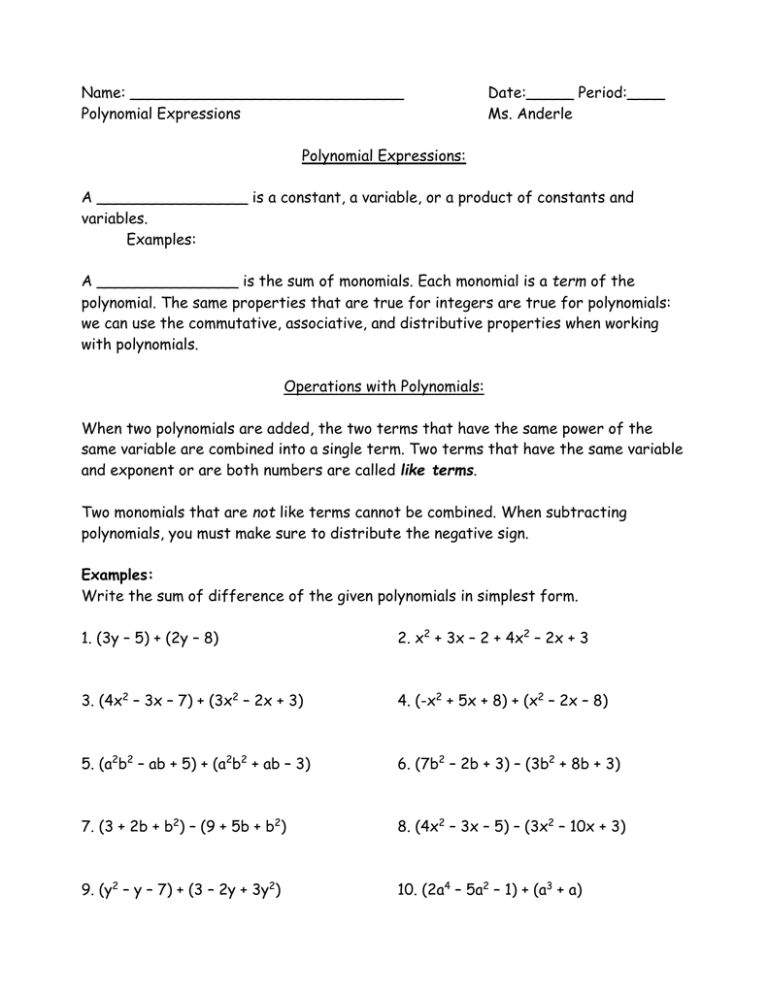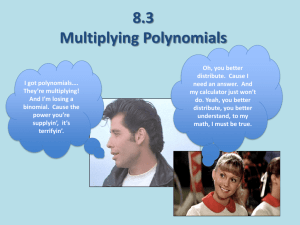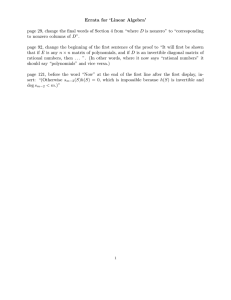Name: _____________________________ Date:_____ Period:____ Polynomial Expressions
advertisement

Name: _____________________________ Polynomial Expressions Date:_____ Period:____ Ms. Anderle Polynomial Expressions: A ________________ is a constant, a variable, or a product of constants and variables. Examples: A _______________ is the sum of monomials. Each monomial is a term of the polynomial. The same properties that are true for integers are true for polynomials: we can use the commutative, associative, and distributive properties when working with polynomials. Operations with Polynomials: When two polynomials are added, the two terms that have the same power of the same variable are combined into a single term. Two terms that have the same variable and exponent or are both numbers are called like terms. Two monomials that are not like terms cannot be combined. When subtracting polynomials, you must make sure to distribute the negative sign. Examples: Write the sum of difference of the given polynomials in simplest form. 1. (3y – 5) + (2y – 8) 2. x2 + 3x – 2 + 4x2 – 2x + 3 3. (4x2 – 3x – 7) + (3x2 – 2x + 3) 4. (-x2 + 5x + 8) + (x2 – 2x – 8) 5. (a2b2 – ab + 5) + (a2b2 + ab – 3) 6. (7b2 – 2b + 3) – (3b2 + 8b + 3) 7. (3 + 2b + b2) – (9 + 5b + b2) 8. (4x2 – 3x – 5) – (3x2 – 10x + 3) 9. (y2 – y – 7) + (3 – 2y + 3y2) 10. (2a4 – 5a2 – 1) + (a3 + a) Polynomials with Rational Coefficients Whenever a polynomial has rational (fractions) coefficients, we must find a common denominator for the fractions. For example: Simplify: 1 1 2 6 Examples: Simplify each expression. Complete work on a separate sheet of paper. 3 3 1 1 1. a 2 a 2 a 2 a 4 2 3 4 8 3 2 2 2. x 3 2x 5 x 3 x 2 5 4 3 3 1 2 1 3 4 3. y 2 y y 2 y 2 5 4 4 3 8 1 5 5 1 3 4. a 2b 2 ab 1 a 2b 2 ab 12 4 2 3 6 1 1 2 7 5. b 2 2b b 2 2 3 8 4 4 2 1 2 4 6. x 2 x 12 x 2 x 4 3 5 15 5 2 1 1 1 7. a 2 a a 2 a 3 8 6 12 9 4 1 3 8. b 2 9b 4 b 2 b 4 5 4 3 1 6 3 6 1 9. y 3 y y 3 y 2 y 4 8 4 5 16 12 5 5 1 3 3 10. b b 2 b 2 b 3 4 2 8 12 6 1 3 3 5 1 11. g 2 g g 2 g 5 8 4 2 3 10 4 5 4 12. b 3 b b 3 6b 2 7 12 9 8 5 1 4 2 5 13. y 4 y 2 y 4 y 3 y 2 8 3 12 6 7 1 4 1 14. b 2 2b b b 2 b 4 21 6 3 2 1 3 1 3 5 15. a 3 a 4a a 2 14 8 7 7 16. 9 a 5 1 a 2 1 a 3 a 5 5 a 3 2 a 2 10 8 2 4 6 7 Multiplying Rational Expressions: Multiplying rational expressions is the same as multiplying numerical fractions. Simply put, we must first multiply the numerators (the tops) and then multiply the denominators (the bottoms). Basically, we are just multiplying across the fraction. Then, we reduce our fractions! For Example: s x sx , where t 0 and y 0 t y ty If possible, you may simplify before you multiply. This might make the problem easier. However, you will get the same answer regardless. Examples: Multiply each rational expression. Simplify each expression. Complete all work on a separate sheet of paper. 1. 18a 3 5b 4 20b 2 6a 2. 12n 3 24a 2b 8ab 2 6n 4 3. 13ab 2 25c 4 20bc 26a 3b 4. 3a 4 8b 2 15b 12a 2b 5. 125x 4 y 2 16n 5 20n 3 25xy 2 6. 14ab 20b 7 16b 4 21a 3b 7. 72d 5e 27d 81e 3 28d 12 8. 60x 2y 8z 2 24z 3 25xy 5 9. 63y 3z 5 9y 10 27z 28y 2 18b 4 16a 10. 3a 2 24b 100a 8b 3 16b 11. 60a 4 15b 5 63y 5 27z 9 12. 49x 4z 2 12y 13 120y 6z 24a 7b 13. 48a 6b 2 21y 4z 44 g 12 99b 3 14. 121b 21 48 g 4 64u 3 24b 15a 15. 3u 16a 7b 5 Dividing Rational Expressions: Dividing rational expressions is the same as dividing numerical fractions. When dividing rational expressions, you must multiply by the reciprocal. Simply put, you keep the first fraction, change the division sign to a multiplication sign, and then flip the second fraction. This is also known as “keep, change, flip.” Then after you “flip” you can reduce anything that needs to be reduced, or you may wait to reduce at the end. s x t y s y For Example: t x sy tx Now Try, 84 48 6 12 Examples: Simplify each expression. Complete all work on a separate sheet of paper. 1. 70y 2z 7 21y 5z 40ab 28a 5 2. 45x 5y 2 36x 7 y 3 64a 12 16a 18 3. 32a 4b 24a 3y 7xy 28x 3b 2 4. 144y 4z 5 48yz 3 20b 2d 15b 6d 3 5. 81d 4e 27d 12e 5 48k 8 16k 4 6. 66z 4 132z 36b 4 12z 8b 7. 98xy 5 14x 4y 3 24b 56b 8 8. 32u 3d 40ub 2 15db 30d 8 9. 125q 5r 2 180q 3 30r 42q 9r 4 Multiplying Polynomials: To multiply polynomials, we use the distributive property. Basically, we are “distributing” each monomial in the first expression to each one in the second expression. Then, combine all like terms. Let’s Try… x 2 x 4 Whenever we multiply two binomials together it is known as ______________. Let’s try something more difficult: x 2 2x 3 x 9 1 2 2 2 x 5x 2 x x 4 5 2 Examples: Complete all work on a separate sheet of paper. Show all necessary work. 1. x 8 x 3 2. x y x 2y 3. 2a 9 3a 1 4. w 4 2w 7 2 5. 9 k k 3 1 1 6. r 3 2r 2 3 7. w 2 9w 2 w 10 10. p 2 p 2 9 p 4 9. 2xy 3 5xy 3 11. r 2 8r 16 4 r 12. 7r 2 12r 5r 8. y 2 9 y 2 3y 4 13. k 2 3k 2 k 2 9k 16. y 2 8y 2 y 2 9y 2 14. 3k 2 12k 3 k 10 15. 9yz y yz 2 1 1 17. y 9 y 2 2 3 1 2 1 18. y 2 2y 1 y 2 y 6 2 2 5 1 1 1 19. x 2 x 2 x 2 10x 2 3 2 4 1 20. 5b 2 b 2 b 2 12 2 5 1 1 2 4 21. 8 g 2 g g g 2 12 2 3








